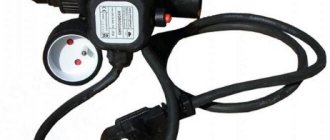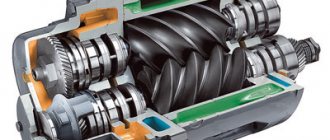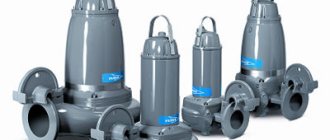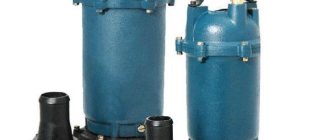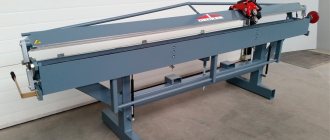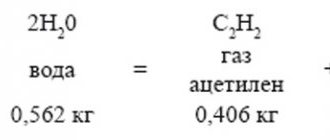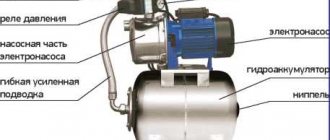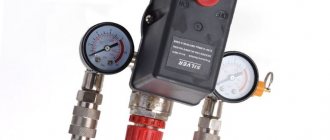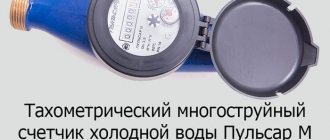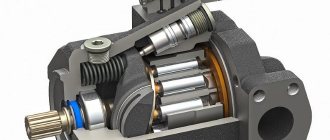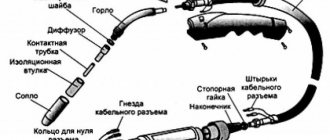1 / 1
We will not go into the jungle of theoretical reflections; we note that the word “reducer” comes from the word “reduce”. It is translated into Russian as “change in the direction of weakening.” It logically follows from this that the oxygen reducer is a device for reducing gas pressure.
Purpose of the oxygen reducer
Technical devices that work with oxygen require a stable inlet pressure. As a rule, the operating pressure of such devices is units of kg/cm2. Oxygen is delivered to the work site either through a pipeline or in cylinders, where the pressure can reach several hundred kg/cm2. For example, the recommended pressure in an oxygen cylinder is 150 kg/cm2.
It should be taken into account that as oxygen is consumed during operation, the pressure in the cylinder decreases. The purpose of the reducer is to provide oxygen at the input of technical devices with constant pressure, regardless of the pressure in the cylinder or gas line.
Reducer for oxygen cylinder. Design and principle of operation
The oxygen in the cylinder used in gas-acetylene welding is under a pressure of 135...150 atmospheres, so the gas pressure should be significantly reduced before work. This role is performed by the oxygen reducer. This device not only reduces the oxygen flow, but also ensures constant operating pressure throughout the entire welding process.
Areas of application
The bulk of technical oxygen is used for gas welding work. At the work site, the oxygen pressure is reduced to the operating level using a reducer. For this purpose, balloon or ramp varieties are used, depending on the method of oxygen delivery (cylinders or line).
Another industry that consumes oxygen is medicine. The technical equipment of this industry is not much different from the field of gas welding work. Gas is delivered in cylinders, then the pressure is reduced by reducers and distributed to the wards and beds. The oxygen supplied is medical grade, standardized. The gas contains at least 99% oxygen and 1% nitrogen. No other impurities are allowed.
Application area
Gearboxes of this type are used in almost all sectors of the national economy. In industry - for assembling and cutting metal structures, in medicine, for organizing the supply of gas to wards and operating rooms.
Performing gas-flame work
Oxygen reducers are used in various industries. In particular, when performing gas-flame work. The reducer ensures a constant supply of gas. In medicine, reducers are installed in the oxygen supply system throughout the wards. Air supply systems in aviation and maritime transport cannot do without such devices.
If you find an error, please select a piece of text and press Ctrl+Enter.
Kinds
Depending on the installation location, they distinguish between BKO and BKD cylinder reducers, which means single-stage cylinder oxygen and two-stage cylinder oxygen with mechanical pressure regulation. To ensure welding, the BKO 50 - 4 reducer is most often used. The marking indicates the device’s ability to pass 50 m3/hour of gas at a pressure of 4 atm.
When powering welding stations from the gas main, SKO network reducers are used. They are used in cases where the gas pressure in the network exceeds the pressure acceptable for consumers. A distinctive feature is the presence of only one pressure gauge, which shows the gas pressure at the outlet of the device.
Centralized gas supply, carried out at high pressure, requires the installation of ramp reducers (RKZ). Their distinctive feature is their large throughput capacity up to 125 m3/hour. They are installed on the high pressure rail directly on the pipeline. Can be operated at oxygen pressures up to 300 bar. They have a built-in inlet filter and a valve to relieve excess pressure.
There are two types of oxygen reducers, differing in operating principles: direct action and reverse action. We will look at the features of their work below. For those who do not want to delve into the intricacies of the operation of these devices, we note that reverse-action reducers are considered more reliable, have a simpler design and allow you to maintain normal operating pressure until the gas in the cylinder runs out.
Characteristic
- Oxygen - designed to regulate the supply of oxygen in the cylinder. Common markings: SKO - 10-2, BKO - 50 mini, RK-70, RKZ - 500-2. Painted blue, secured with union nuts. Capacity from 10 to 500 m3/hour. The price varies from 1600 to 21500 rubles.
- Propane - regulates the supply of propane. Markings: BPO - 5, SPO - 6, RDSG-1-MTL (frog). Painted red, secured with union nuts. Throughput from 1.5 to 1.6 m3/hour. Price – from 400 to 1600 rubles.
- Carbon dioxide - to regulate the supply of carbon dioxide. Markings: UR-6-6, BUO-5-4. Can be painted black or red and blue. Fastened with union nuts. Capacity 5-6 m3/hour. Price 900-1500 rubles.
- Acetylene - regulate the supply of acetylene. Markings: BAO-5-4, RAO-30-1, SAO - 10. Fastened with clamps. Painted white. They pass from 5 to 30 m3/hour. Price from 1600 to 14300 rubles.
- Argon. Markings are: AR-40-4DM, AR-40-KR1-mr. Color white or black. They pass 1.8-5.4 m3/hour. Price 1400-1750 rubles.
- Helium. For helium regulation. Marked: G-70-KR1, G-70-KR1-m. Fastened with nuts. Color white or black. Bandwidth 4.2. Price about 1500.
| Characteristics, name | color | Mounting method | throughput (highest value) m3/h | gas pressure at the inlet, (maximum value) MPa (kgf/cm2) | operating gas pressure, (maximum value) MPa (kgf/cm2) | Weight no more, kg | Price, rub.) |
| Oxygen species | |||||||
| SKO - 10-2 | blue | Union nuts | 10 | 1.6 (16) | 0.5 (5) | 1.5 | 2600 |
| BKO - 50 mini | 50 | 20(200) | 1.25 (12.5) | 0.85 | 1600 | ||
| RK-70 | 100 | 20 (200) | 7 (70) | 12.2 | 5910 | ||
| RKZ - 500-2 | 500 | 20(200) | 1.6 (16) | 10 | 21500 | ||
| Propane types | |||||||
| BPO-5 | red | Union nuts | 5 | 2.5 (25) | 0.3 (3) | 2 | 1300 |
| SPO - 6 | 6 | 0.3 (3) | 0.15 (15) | 1.8 | 1400 | ||
| RDSG-1-MTL (frog) | 1.5 | 1.6 (16) | 0.2-0.36 (2-3.6) | 0.2 | 400 | ||
| Carboniferous species | |||||||
| UR-6-6 | black | Union nuts | 6 | 10 (100) | 0.6 (6) | 0.61 | 900 |
| BUO-5-4 | Red Blue | 5 | 10 (100) | 0.35 (3.5) | 1.3 | 1500 | |
| Acetylene species | |||||||
| BAO-5-4 | white | Slip clamp | 5 | 2.5 (25) | 0.15 (1.5) | 0.6 | 1600 |
| RAO-30-1 | 30 | 2.5 (25) | 0.1 (1) | 10 | 14300 | ||
| SAO - 10 | 10 | 0.12 (1.2) | 0.1 (1) | 0.8 | 2600 | ||
| Nitrogen species | |||||||
| A-90-KR1-m | White and black | Union nuts | 5.4 | 20 (200) | 1.0 (10) | 0.74 | 1900 |
| A-30-KR1 | 1.8 | 20 (200) | 2.2 (22) | 0.8 | 2600 | ||
| Argon species | |||||||
| AR-40-4DM | black | Union nuts | 2.4 | 20(200) | 0.8 (8) | 0.78 | 1750 |
| AR-40-KR1-m-r | white | 2.4 | 20 (200) | 1.0 (10) | 0.78 | 1400 | |
| Helium species | |||||||
| G-70-KR1 | white | Union nuts | 4.2 | 20 (200) | 1.6 (16) | 0.8 | 1500 |
| G-70-KR1-m | black | 4.2 | 20 (200) | 1.6 (16) | 0.74 | 1200 | |
Operating principle
The simpler the device, the more reliable it is. The beauty of gas reducers is that their operation is based on a very simple principle of comparing two pressures. One pressure is what comes from the cylinder, and the second is the spring pressure.
We cannot influence the gas pressure in the cylinder, but we can increase or decrease the spring pressure. The difference between these pressures will be the required operating pressure. This simple principle is not difficult to implement.
What else you should know when working with a gearbox
As you know from a school chemistry course, oxygen is a strong oxidizing agent and therefore work with it must be carried out in strict accordance with the requirements of safety and labor protection rules. In particular, oxygen and oils must not be allowed to come into contact; such contact will result in an explosion.
Gas is often delivered to workplaces in cylinders with a pressure of 14.7 MPa. Therefore, when handling them, certain safety rules must be observed. In addition, the cylinder must not be dropped, hit, stored from fire, etc. The oxygen reducer installed on it must be covered with a durable casing.
Oxygen reducer device
The design and operating procedure of the gearbox is best viewed in the figure (see below). Let's consider the operation of a reverse-action gearbox, as the most common. Oxygen flows from the cylinder into inlet 1.
The adjusting screw 9 is screwed in, the setting spring 10 is compressed and with its force it lifts the membrane 11 up. The membrane with its pusher 12 opens the valve, overcoming the force of the upper spring 3. Gas begins to flow into chamber 8 and into the outlet fitting.
As soon as the gas pressure in chamber 8 exceeds that set by the control screws, membrane 11 will bend down and pusher 12 will close the valve. Gas continuing to escape through the outlet fitting will lead to a decrease in pressure in the chamber, and the cycle will repeat again. The adjusting screw has a fine thread, which allows you to very accurately set the operating pressure. To control the pressure, pressure gauges are installed at input 2 and output 7 of the reducer.
To avoid an emergency increase in pressure in the chamber, a safety valve 6 is installed on it, which “bleeds” excess pressure into the atmosphere. The figure is presented in a simplified form for a better understanding of the process. In a real device, several filters of various designs are also installed to purify the gas.
Characteristics and Features
For the correct selection and trouble-free operation of the gearbox, you need to know its purpose and characteristics. Manufacturers and trading organizations accompany their products with the following set of characteristics:
- type of gearbox (reverse or direct acting);
- number of steps;
- throughput;
- working pressure value;
- maximum inlet pressure;
- Climatic performance.
When describing the device, we focused on a reverse-action gearbox. This is due to the fact that this type is found everywhere and has decisive advantages over the direct-acting reducer in the form of reliability and conditions for using gas from a cylinder. A detailed description of the operation of a direct-acting gearbox may be of interest only to highly specialized specialists. For most users, it is enough to know that the difference between them is that in a direct-acting reducer the gas pressure from the cylinder tends to open the valve, while in a reverse-acting reducer it tends to close it.
Gearboxes come in single-stage and two-stage types. Single-stage ones are most widespread. They are simpler in design and, accordingly, cheaper. Two-stage ones are more complex and expensive, but there are cases when you can’t do without them. The presence of intermediate chambers in a two-stage reducer prevents the possibility of freezing of the reducer when operating with high gas flow rates at low temperatures. They allow operation at subzero temperatures and pressures up to 200 atmospheres.
Characteristics such as throughput, operating pressure and maximum inlet pressure are intuitively understandable and do not require special explanation. Climatic design takes into account the characteristics of work in various climatic zones (heat, cold, dampness, humidity, etc.).
Types and characteristics. Gearbox BKO 50-4 and BKO 50-5
According to their technical parameters, reducers for oxygen cylinders are divided into two groups - ramp and station. Ramp gearboxes are characterized by increased throughput - from 100...120 m3/h, and therefore are used to power a group of welding stations, or for welding work with large volumes. Station reducers are for individual purposes; they provide oxygen consumption in quantities of 5...25 m3/h (lower values correspond to lower final gas pressures).
The housings of gas reducers are of the same type in appearance, so during manufacture they are painted in certain colors (for oxygen reducers this is blue).
GOST 13861 provides for the following versions of oxygen reducers:
- Cylinder type BKO, BKD and BPO.
- Network, such as SKO, SAO, SPO, SMO.
- Universal (U).
- Ramp (RKZ, RAD, RPD).
- Central (CDC).
The main technical characteristics of an oxygen reducer are its throughput and the operating pressure of the gas in the cylinder. For example, an oxygen reducer type BKO 50-4 means that the unit is designed to be connected to an oxygen cylinder, is single-stage, and is designed for a throughput of up to 50 m³/h at a gas operating pressure of 4 atmospheres. Accordingly, for the BKO 50-5 oxygen reducer the permissible operating pressure is 5 atmospheres. It is the BKO type gearboxes that are most often used for individual gas welding stations.
Additional operational features of oxygen reducers are:
- Number of reduction stages. Single-stage devices are produced, in which the pressure regulator is either a spring or another unit, and two-stage ones, where pressure regulation occurs gradually, using intermediate pneumatic chambers. Two-stage gearboxes provide more reliable operation of the welding station at low temperatures, are more stable in their characteristics, but are characterized by structural complexity and, therefore, increased price;
- Connection method. A union nut is used rather than a clamp, since the explosiveness of oxygen requires special requirements for tightness;
- Climatic performance. The requirement for reliable operation of the current regulator especially increases when gas welding is carried out not only at low temperatures, but also with large volumes. At high flow rates, the oxygen pressure quickly decreases, which is accompanied by an increase in the volume of gas remaining in the cylinder. This physical process accelerates the cooling of the gas and the reducer, as a result of which the device may become inoperable.
The fundamental differences of a two-stage oxygen reducer are a high-precision reducing valve and a double-layer membrane of increased area, which is made of high-strength synthetic rubbers. Such material is insensitive to changes in external temperature, due to which the membrane retains its functionality at negative temperatures and gas pressures of up to 150...200 atmospheres.
Setting up the oxygen reducer
Similar actions must be carried out when preparing a newly installed oxygen reducer for operation. The first step is to make sure that the pressure gauges located on the gearbox are in good working order. The pressure gauge arrows must strictly point to “0” and not move when turning and moving the gearbox.
Before attaching the hose to the cylinder fitting, you must ensure that the adjusting screw rotates smoothly. Fully unscrewing the screw ensures that the oxygen supply stops.
It would not be superfluous to make sure that the entire assembly is tight. To do this, you need to connect the burner, open the oxygen supply to it, set the operating pressure with the adjusting screw and coat all joints with soapy water. The absence of soap bubbles will indicate their tightness.
After all the above measures, wipe the gearbox and once again visually check for stains that may be oils or fats. In suspicious cases, it is better to wipe everything with solvent again. Now you can start the test run.
How to work with an oxygen reducer
When working with oxygen reducers, it is necessary to carry out several preparatory operations.
- Check the serviceability and integrity of the pressure sensors. The arrows must be set to zero and not change their position when turning the gearbox.
- Before connecting the gas supply hoses, it is necessary to check whether the operating screw that regulates the closing of the valve is turned out.
- After connecting the hoses, it is necessary to configure the device to supply the pressure necessary to perform the work.
Working with an oxygen reducer
In addition to the above operations, it is necessary to check the gearbox for leaks. To do this, the screw must be unscrewed completely.
Check the threaded connection for traces of oil and grease; if found, they must be removed immediately using a solvent.
By the way, you can check the tightness by applying soap foam to the threaded connections. If bubbles appear, work must be stopped and the gearbox must be sent in for repair.
Tips for selection and rules of use
When choosing a gearbox, the placement point should be taken into account. No special explanation is needed; it is clear that a ramp or network reducer cannot be installed on a cylinder. You cannot install an argon or carbon dioxide reducer on an oxygen cylinder. Make sure that the possible maximum gas inlet pressure does not exceed that allowed for this type of reducer. If this condition is violated, preconditions are created for emergency destruction of the product. Select the device according to the required operating voltage.
Making a choice between a single-stage and a two-stage gearbox is easy. In 99% of cases, one step is enough for you. And only under specific operating conditions may two stages of pressure reduction be necessary. This will necessarily be specified in the technical documentation for the technological process. The same is with the climatic version: if you work in a normal climatic zone, then the climatic version will not interest you at all.
To avoid running into a fake, carefully read the markings on the case. The manufacturer's logo, product brand and production date should be clearly visible here. Compare this information with that specified in the device documentation.
Issues of setting up and preparing for operation of the equipment were described above. Let's add a few more simple rules necessary for safe work. During operation, it is necessary to constantly monitor possible leaks and freezing of the gearbox.
When stopping work for a short time, it is enough to close the valve on the cutter. When stopping for more than 15 minutes, you need to unscrew the adjusting screw; this will protect the adjusting spring from damage. At the end of the working day, it is recommended to remove the reducer from the cylinder and place it in a box.
Rules for safe operation
Considering the explosion and fire hazard of oxygen, such products, in accordance with GOST 12.2.008-75, must be periodically subjected to thorough routine maintenance. In relation to oxygen reducers of type BKO 50-4 and BKO 50-5, maintenance rules include:
- Checking the movement of the adjusting screw/flywheel from one extreme position to another: it should be smooth and without jamming.
- The connecting elements must not have external mechanical damage - cracks, scratches, and also be cleaned of oil, grease and dirt.
- Periodic checking of pressure gauges should not be less than once a year. The criterion for the need for verification is considered to be increased inertia of the instrument needle.
- Parts that do not meet the operating conditions of oxygen reducers cannot be used as sealing elements - gaskets, nipples, etc.
- Before each use, the tightness of the connections is checked (using a pressure gauge); leakage of oxygen from the cylinder is unacceptable.
- When an oxygen cylinder is connected to the reducer, it is prohibited to make any adjustments.
- According to labor safety rules, it is necessary to provide for the installation of safety devices between the reducer for the oxygen cylinder and the rest of the gas welding equipment, including those for extinguishing the flame. These can be check valves designed for the pressure in the cylinder, as well as safety valves.
The price of an oxygen reducer is determined by its design and operational capabilities. For single-stage gearboxes, the price ranges from 1800...2000 rubles. (BKO 50-4) and 1100...1200 rub. (BKO 50-5). Two-stage devices (for example, BKD-25 or Multi-Stage RG S2 O2 made in Czech) are much more expensive - 11,000...12,000 rubles.
— Search by diary
— Subscription by e-mail
— Statistics
Saturday, January 28, 2021 15:07 + to quote book
Operation of the gearbox.
Before connecting the oxygen reducer, you must carefully check whether there are any traces of oil, etc. on the fitting and union nut. If traces of fatty substances are found, the reducer must be washed in some solvent (for example, aviation gasoline).
Next, you need to check the serviceability of the thread of the union nut, clean it from dirt and dust, and also check the presence and serviceability of the fiber (for oxygen gearboxes) or leather (for acetylene gearboxes) gasket, on which the tightness of the connection between the gearbox and the valve depends.
After blowing out the oxygen valve of the cylinder or line to remove dirt or chips from them that could get into the reducer and damage its valve, the union nut of the oxygen reducer is screwed to the valve fitting and secured with a wrench.
In the same way, it is necessary to purge the valve of the acetylene cylinder before attaching the acetylene reducer to it.
Before releasing gas into the reducer, its adjusting screw must be turned out until the pressure spring is completely weakened, so that when opening the cylinder valve, the reducer cannot be damaged. The shut-off valve on the gearbox must be open. A hose is attached to the hose nipple of the gearbox and secured firmly with clamps or soft wire.
To release gas into the reducer, you must smoothly open the cylinder valve half a turn of the handwheel. If no abnormalities are observed, then the cylinder valve should be opened all the way and by rotating the pressure control screw of the gearbox clockwise, set the required operating pressure using the pressure gauge. The operating oxygen pressure is set when the cutter valve is open.
When, due to the presence of oil or a sudden release of oxygen, a flash or strong heating of the gearbox occurs, it is necessary to quickly close the cylinder valve, and remove the gearbox and send it for repair.
After establishing the operating pressure, it is necessary to check whether there are gas leaks at the joints, along the threads of pressure gauges, etc. Gas leaks are dangerous, since acetylene and other flammable gases form explosive mixtures with air.
After checking, the torch is ignited and the flame is adjusted.
During operation, it is necessary to ensure that there are no leaks, freezing, etc. in the gearbox.
When you stop working for 2-3 minutes. Only the valves on the cutter can be closed. If work stops for 10-15 minutes, then in addition to the cutter valves, close the gearbox shut-off valve without changing the position of the control screw. During breaks in work for more than 10-15 minutes. You should additionally loosen the pressure spring by unscrewing the adjusting screw.
During long breaks and at the end of work, the valve of the cylinder or line is closed and the gas remaining in the reducer is completely released. Then, by turning the adjusting screw counterclockwise, the pressure spring is weakened.
Where to buy an oxygen reducer
You can get rid of many surprises and troubles when operating a gearbox at the stage of purchasing it. To do this, you need to choose a time-tested manufacturer. The group is a reliable manufacturer and supplier of welding equipment in Russia, Europe and Asia.
On our website you can familiarize yourself with the characteristics, get detailed advice and buy a reducer for an oxygen cylinder BKO-50-4M in a climatic version from -25°C to +50°C and a reducer for reducing gas pressure BKO-50 for operation in the temperature range from -15° to +15° С.

